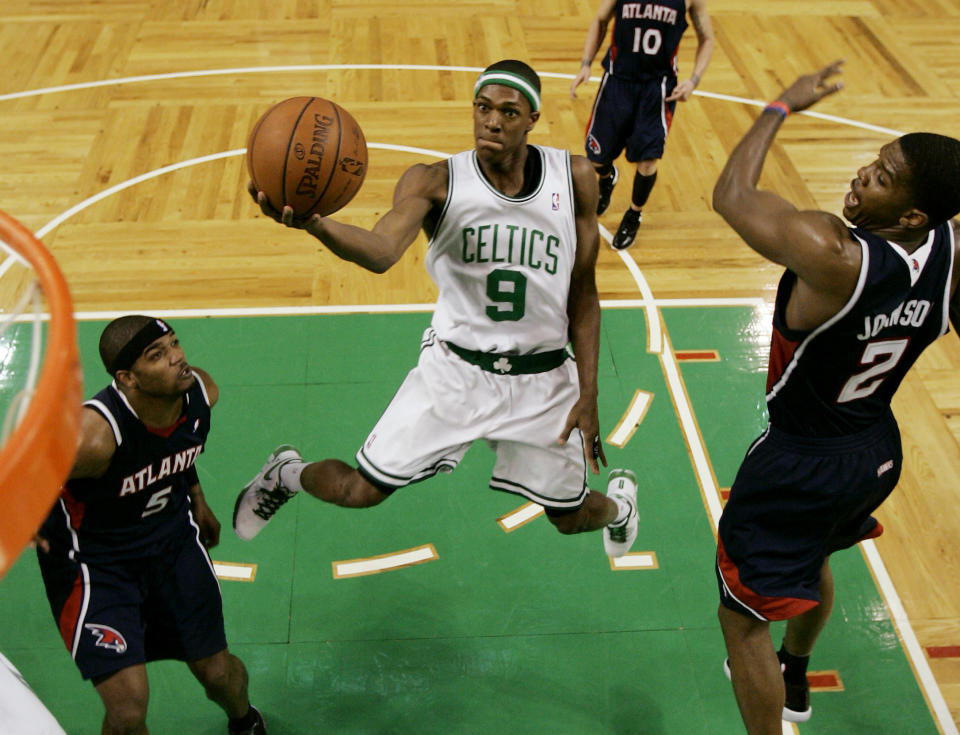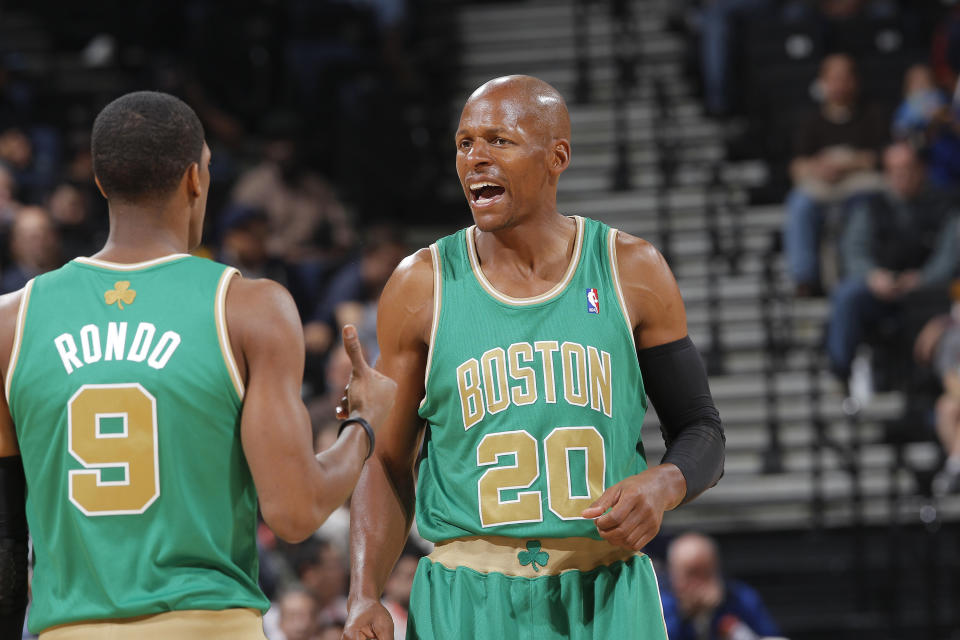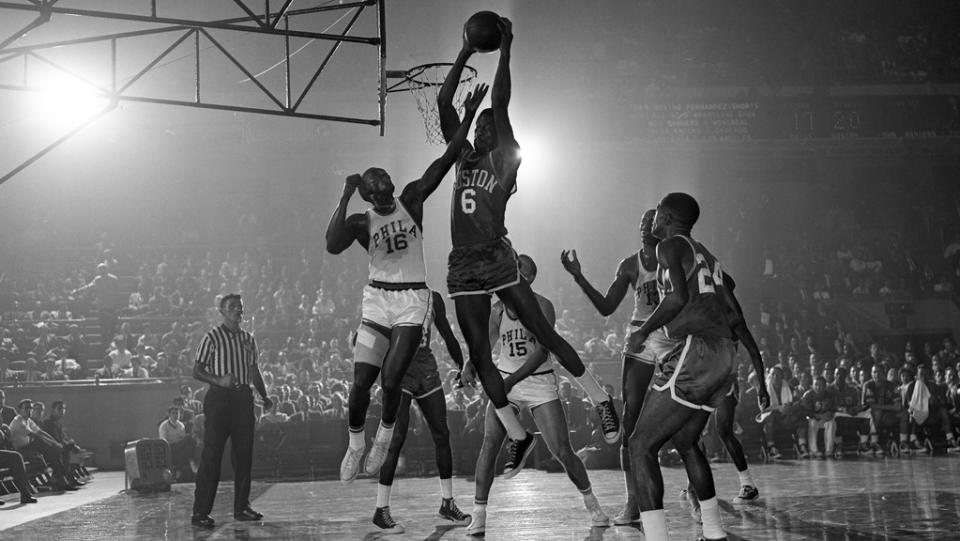What are the 5 biggest Celtics trades made during the NBA draft?

The NBA draft is all about roster design. There are a lot of different strategies out there, but let’s stick with what legendary Boston Celtics coach Red Auerbach once offered: “They said you have to use your five best players but I found you win with the five who fit together the best.”
With that frame, the draft offers a tantalizing number of opportunities. Sure, you can select the best available player and hope he grows with your system. But fortune favors the bold — the NBA draft is a chance to really swing for the fences and bring in the right player. A smart trade on draft night can change everything.
Boston, unsurprisingly, has a history of moving and shaking far beyond the limited frame of their own specific pick. Following the leadership of Auerbach, the Celtics’ NBA draft trade history is a rich and storied one. As we’ll see, some of the franchise’s best players landed in green by way of a draft-day trade. Let’s discuss.
The Celtics land Jayson Tatum (2017)

(Michelle Farsi/NBAE via Getty Images)
Boston owned the No. 1 pick in the 2017 NBA draft, despite a 53-win season the year before. The Celtics landed the top spot by way of a pick-swap with the Brooklyn Nets. Hot off of a trip to the conference finals, Boston was set to add to its already exciting roster.
Then-president of basketball operations Danny Ainge struck a rather bold deal, however. He and the Celtics wanted Duke’s Jayson Tatum, but were willing to take a risk in landing the St. Louis native. Boston traded the No. 1 pick to Philadelphia in exchange for the No. 3 pick and a future first. The Sixers selected Markelle Fultz, the Lakers took Lonzo Ball, and the rest is history.
This deal was actually reported a few days before the draft itself, but we can still include it on our list of Celtics NBA draft trades. And maybe in time this trade will actually qualify as an even more important move for the franchise. But as we’ll see, Boston has really struck gold with draft-day trades.
Boston trades for two point guards (2006)

(AP Photo/Winslow Townson)Following the 2005-06 season, it was clear the Celtics needed a point guard. Delonte West and Marcus Banks just weren’t the right quarterbacks for Boston’s offense. Heading into the draft, the club was eager to make a move — Ainge would end up making two deals on the evening, and by the end of the night, the Celts had two new point guards.
With the No. 21 pick, the Suns drafted Kentucky’s Rajon Rondo. Phoenix then traded Rondo and Brian Grant to Boston in exchange for a 2007 first-round pick. In a separate deal, the Celtics landed Sebastian Telfair, Theo Ratliff, and a second-round pick from Portland in exchange for the No. 7 selection Randy Foye, along with Dan Dickau and Raef LaFrentz.
Telfair became the starting point guard for the team the following season, but the pairing wouldn’t last. Boston ended the ’06-07 season with just 24 wins. Rondo showed some promise as the team’s backup PG, a fleeting silver lining for a disastrous season.
In April, the team announced it was cutting ties with Telfair, naming Rondo the starting point guard. A year later, Rondo and the Celtics were marching to the NBA Finals. Things move quick in the Association, sometimes precipitated by the right draft night trade.
Hail to the Chief (1980)

(AP Photo/David M. Tenenbaum)
Change was in the air in Boston in the spring of 1980. Dave Cowens had retired, but Larry Bird looked ready to lead the next chapter of Celtics basketball. Now serving as team president, Red Auerbach was armed with the top selection at the draft, which was scheduled for June 10th, and eager to make a splash. The day before on June 9th, Red made his move.
Boston traded the No. 1 and No. 13 picks in the 1980 draft to the Warriors in exchange for big man Robert Parish and the No. 3 overall selection. (The Celtics previously landed these two picks by trading Bob McAdoo to the Pistons in September of 1979, which in turn was part of a larger compensatory package when Boston signed ML Carr in July of that year.)
With Parish slated to join the Celts, the Warriors selected Joe Barry Carroll with the No. 1 selection. Two picks later, Boston took Kevin McHale from the University of Minnesota. With a spiffy new backcourt, the Celtics went on to win the NBA title in 1981, ’84, and ’86. Not bad.
Here comes Ray (2007)

(Rocky Widner/NBAE via Getty Images)
Robert Parish and Kevin McHale are decidedly Celtics royalty. The moves made around the 1980 NBA draft changed everything for Boston. Because Larry Bird was already on the team and the C’s were set with the No. 1 overall pick, however, it’s more of a clever use of resources rather than a rags-to-riches move. For that story, we head to 2007.
During the that year’s NBA draft, the Celtics did something unexpected. They traded Delonte West, Wally Szczerbiak, and the No. 5 pick that became Jeff Green to Seattle. In exchange, Boston received All-Star Ray Allen and LSU’s Glen Davis.
“To make the decision to move a player — and a person — like
Ray Allen was tremendously difficult,” then-Supersonics general manager Sam Presti said. “Boston really pursued this. What started as a smaller conversation became fulfilled. Their pursuit was impeccable.”
At the time, it wasn’t clear why the lowly Celtics would trade away some of their prized young talent. Could an aging Ray Allen help calm Paul Pierce and right the ship?
A month later, Kevin Garnett joined Allen and Pierce in Boston. Landing the former MVP solidified the beginning of the Big Three era. But it was a risky draft night trade that started the party.
Celtics trade for Bill Russell (1956)

(Charles Hoff/NY Daily News via Getty Images)
The Celtics have seventeen championships banners hanging from the rafters in Boston’s TD Garden. Bill Russell helped earn eleven of them. Were it not for a spectacular draft-day trade in 1956, though, NBA history may have looked very, very different.
A two-time NCAA champion at the University of San Francisco, Russell caught the eye of coach Red Auerbach, who believed his Celtics lacked defensive intensity. Unfortunately, Boston owned the No. 7 pick in the coming 1956 NBA draft and had already used its territorial selection on Tom Heinsohn. The Celtics had a plan.
First, Boston traded the No. 7 pick, Ed Macauley, and Cliff Hagan to St. Louis for the No. 2 pick. Macauley and Hagan were established players. This was a shrewd move only in retrospect, if only because the Rochester Royals still had the No. 1 selection. Two things worked in the Celtics favor here.
First, the Royals already had a big man in Maurice Stokes and didn’t want to pay the $25,000 signing bonus Russell was seeking. Celtics owner Walter Brown called Rochester’s front office to confirm this dynamic.
Brown was also the owner of the Ice Capades, and according to Auerbach, Brown even told Royals owner Les Harrison that he would guarantee the theatrical skating club would make a trip to Rochester if indeed the Royals passed on Russell. After an unbelievable bit of jockeying, the Celtics were able to select Bill Russell with the No. 3 overall pick in 1956.
This post originally appeared on Celtics Wire. Follow us on Facebook!
[mm-video type=video id=01g65nk51t6s0jzg8esx playlist_id=01eqbzegwgnrje4tv2 player_id=01eqbvq570kgj8vfs7 image=https://images2.minutemediacdn.com/image/upload/video/thumbnail/mmplus/01g65nk51t6s0jzg8esx/01g65nk51t6s0jzg8esx-73151f5e8a79c88fcf676d6547189aad.jpg]
[lawrence-related id=104821,104806,104804,104707]
[listicle id=104720]
[listicle id=104760]
[listicle id=104711]
1
1
1
1
1
1

